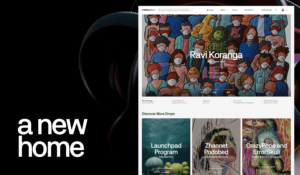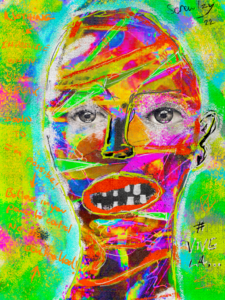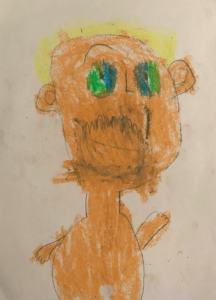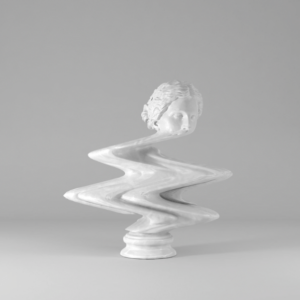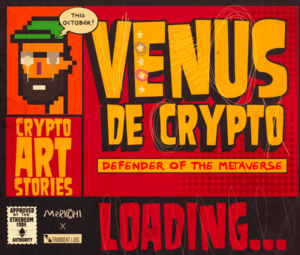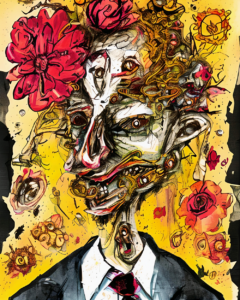
Listen to the episode on Apple Podcasts, Spotify, Overcast, iHeart, PlayerFM, Podchaser, Boomplay, Tune-In, Podbean, Google Podcasts, Amazon Music, or on your favorite podcast platform.
Learn more about this episode
Brady Walker: Our guest today is a multi-talented artist and music executive, Otha “Vakseen” Davis III. Vakseen’s work has been exhibited in museums and featured by major brands such as Nike, Adidas, and Bombay Sapphire Gin. He is also a diamond and multi-platinum music executive, producer, and songwriter.
Born to a military family in Athens, Georgia, and raised in Jacksonville, Florida, Vakseen grew up artistically inclined, playing several instruments including the violin. He is best known for his vibrant acrylic portraits, including his “Vanity Pop” series that celebrates diversity, and the “Legends Only” series that celebrates pop and cultural icons.
Vakseen’s art has been described by one of his collectors as having the ability to set the stage for a much-needed therapy session that challenges one to get to the root of any issues hindering progress or living one’s best life. He believes that his art serves as his own antidote to maintaining sanity in the fast-paced entertainment industry.
Despite his success in the music industry, Vakseen has been an active contemporary realist painter since moving to Los Angeles in 2011. His work has been shown in countless gallery exhibitions and featured in over 100 print and online magazines worldwide.
Vakseen’s aim is to produce art that consistently ignites discussion, captivates the senses, and connects people with his culture. He hopes to inspire young creators, especially those who look like him, to know that their voice is powerful, it matters, and every single dream is possible.
It’s an honor to have Vakseen as our guest today. Let’s dive into his journey and hear more about his passion for art and music.
And without further ado, please enjoy my conversation with Otha Davis III, aka Vakseen.
Brady Walker: Where did your creative journey start? And where is it taking you?
[2:31] Vakseen: My creative journey started at the youngest of ages. Art was my first love from day one. As a child, I used to draw and doodle things like stick figures. However, what I really began to pursue was music. I think it was due to its accessibility and the potential for a career. Music was really where my creative journey began.
In high school, I started writing and became part of a four-member rap group. By the time we graduated, we had whittled down to a duo. Then, I went to college, but after my second year, I realized that wasn’t for me. That’s really when I began to take my art and craft more seriously.
I dove into learning production and engineering. We were limited on resources financially, but as a curious creator, I wanted to learn as much as I could. I wanted to be involved in the business side of things. I was handling all the business for our group, producing our music, and directing our overall vision. I had an opportunity to get into the business when I started as an intern around 2004 or 2005 at Slip-N-Slide Records, a major hip hop indie label.
This move took my career to a completely different level. I was ready, but I couldn’t anticipate what was coming. I was blessed to accomplish a lot in music, which ultimately led me back to art, my main focus now.
There’s a lot of work that’s been put in to ultimately reach this point. It’s opened tremendous doors for me. On the music side of things, I’ve been blessed to achieve things that most people want. I have a diamond record, number one Billboard records and albums, Platinum plaques, and gold plaques. I’ve been extremely fortunate in this journey. For me, it’s always just been about pursuing what I’m passionate about. At the same time, I’ve been able to help up-and-coming creators achieve that same level of success by creating a team. Our mission was to take care of creators, help them open doors, and ensure they weren’t taken advantage of, which happens a lot in the creative space.
I like to think that the way I’ve blessed so many people in the music space has come back to me on my art journey, which tends to be more of a journey of solitude. I just had my 10th museum exhibit, and it’s still ongoing. I just finished a project with the History Channel.
This journey has been incredible. I celebrated 10 times during Black History Month by various major brands, the mayor of Miami, and even a fourth-grade class in Nashville that learned about me and my work. The journey has opened tremendous doors. It’s been an incredible journey. And with everything I’ve accomplished, I feel like I’m just getting started at every point, like right now, I feel like I just started yesterday.
[7:35] Brady Walker: What would you say about your relationship to creativity and collaboration? Because music is so collaborative? What about your attitude or your way of relating to that? Do you think your success is attributed to something other than your work ethic? I can imagine that there’s somebody who would go equally as hard as you did, but not encounter the same successes.
[7:51] Vakseen: Well, my intuition, hands down. My intuition has guided me. It’s something that I’ve been cultivating since a young age.
I had a traumatic experience when I was younger. Long story short, I had a daughter, and found out at five, she wasn’t mine. This was one of my first relationships. There was something that told me to get out of that situation early on, which I didn’t pay attention to. Later, I realized that was my intuition.
It was a major lesson. I walked away from that experience understanding how important it is to listen to that voice in your head at all times. The times that I haven’t, those are the times where I end up in a regrettable situation, which isn’t often. My intuition, that’s what has helped me maneuver and just make the best decisions. There are plenty of people that can work just as hard as me or harder. But it’s key to know what opportunities are for you, and which ones aren’t.
A lot of things that are presented as an opportunity may not help you achieve your goals. So, just paying attention to the fine details, just as I do as an artist, is crucial. That’s who I am as an artist, paying attention to those fine details and moving accordingly. Moving on those hunches, moving on that intuition, those feelings that you get behind different situations.
That’s honestly what connected me with makersplace. I didn’t know anything about NFTs when I was contacted. It just felt like it was something I should be a part of. As artists, it’s our job to forecast what’s coming up in the world.
It felt like NFTs were the next wave. So, it’s another example of using that intuition. I can think of millions of examples where following my intuition paid off. So, I definitely think that’s the key.
[10:43] Brady Walker: Were there any situations where following your intuition led you down a path that you might not have wanted to go down?
[10:55] Vakseen: Perhaps, but I can’t really think of anything specific at the moment. If that did happen, there’s always a lesson to be learned. We can always make mistakes in life, but the key for me is learning from these situations. I don’t even consider them mistakes because they all end up being lessons that help us advance in our journey.
[11:23] Brady Walker: Is there a particular mentor that you’ve had in your life that’s had an outsized impact on your creative life and on your creative career?
[11:36] Vakseen: I’ve always had people cheering me on. I can’t say I’ve ever had a full-on mentor, but I’ve had people who have taken on mentor-like roles in my life. When I hear the word “mentor,” I think about someone who opens doors for you, educates you, and guides you in the right direction.
In music, I had Livio Harris. He was a tremendous help when I moved to Los Angeles. He’s a legend in the music game. I also got my first job in music at Slip-N-Slide Records, and I would consider the CEO, Ted Lucas, somewhat of a mentor. He gave me a huge opportunity, which provided a foundation for me to stand on.
Then there’s LC Cross Ski, who was with Big Space Projects. He mentored me for a bit, guiding me and putting me in different shows. I’ve definitely had people who saw my potential and were willing to assist. I think that’s key. As artists, we all need someone to believe in us, whether it’s someone in a mentor role or someone in a support role. It’s definitely important.
[13:26] Brady Walker: You mentioned earlier how you fill this role for other up-and-coming artists. This was in the context of music, I believe. Can you tell me how you approach mentoring young artists?
[13:46] Vakseen: It’s kind of the same thing I just voiced. If I see potential, if I believe in someone, I’ll do anything for that person, regardless of the level of our relationship.
In my journey, I’ve come across creatives that I believe in as much as I believe in myself. I know how challenging it is to make it as an artist. There’s no set handbook that’s going to work for every single person, even though there are plenty of books to read and educate yourself on.
Bigger than anything, I always wished I had somebody to guide and steer me, so I became that for a lot of creators. That may have been me closing deals, presenting opportunities, and to be honest, there wasn’t much I wouldn’t do for the people I’ve mentored just because I believed in them that much.
[15:01] Brady Walker: You mentioned books to read. This isn’t a question I had written down. But I’m curious to know if there are any books that you would recommend as sources of either practical guidance, or kind of more philosophical for any artists who are listening.
[15:27] Vakseen: Certainly, there are books on music and business, like “Everything You Need to Know about Music Business” by Donald Passman. That’s kind of considered the Bible in music. Another book is “Make It Happen” by Kevin Liles, a major exec in entertainment who started as an intern. That was definitely an inspiring read for me. However, I think the best reads that influenced my journey are outside the scope of specifically dealing with art. I am self-taught in every aspect, so it’s just about learning as much as possible about life, people, how to maneuver differently, how to get to your goals, and bring everything to life.
[16:53] Brady Walker: That’s helpful. Moving a little bit more toward your art practice. I’m curious to know how you think about balancing consistency versus eclecticism in your work and from piece to piece.
[17:35] Vakseen: Consistency is the only thing that matters to me. That’s number one, consistency, and growth, evolving. Those are two things that are number one on my list. Coming into my career, I started in music in my early 20s, and I was realistically creating in high school. I still have a toe in now. But art is really the full focus day in day out. Before I moved to LA, art was not on my radar. I wasn’t pursuing it consistently. So it was fresh when I made a conscious decision to pursue art on January 1, 2012.
Because of the success that I’ve had in music, I understood the importance of having a distinct style as a creator, which sets you apart from the competition. I’d get carbon copies submissions as an A&R from across the world, and they all sound like whatever artist is in at that moment. So when I started on my art journey, I was creating organically, but I was paying attention to what worked. I noticed that my work was cohesive and that it was intended to be feminine, or something related to celebrities, which aligns with my ties to entertainment.
So within that first year, I was just creating, but keeping my eyes open for something that I felt was distinct, something people resonated with. I’m known for the “Legends Only” series, and for “Vanity Pop.” But in the fine art world, I’m known solely for my “Vanity Pop” series. The Legends Only series is something that I did, and ironically, I did the first portrait in that same style with colorblocking in high school.
It’s very important to have a distinct style, something people can recognize when they see your work. It’s important to embrace my individuality. And while I understand it’s important to keep things cohesive and consistent, it’s also about growth while keeping it consistent and cohesive.
[21:57] Brady Walker: How do you go about creating a unique style or discovering unique style? I can definitely pick out a Vakseen out of a pile of 50 paintings. Could you share your journey to finding your style and deciding on what you’re going to be known for?
[22:16] Vakseen: I tried different things. The biggest thing for me as an artist is we’re given these gifts to create, to share. Once we share, and put it out into the universe, it’s important for me to pay attention and see how my work resonates with people. We all want to be appreciated for what we create. So, I paid attention to what worked. Once I saw that people resonated with my work, I listened to what they were telling me. That’s all you have to do – pay attention. And that’s what I did. It’s not necessarily easy, but you just have to be willing to receive guidance from the universe.
[24:04] Brady Walker: That definitely fits with what you were talking about with regard to intuition. It does sound like a journey that requires antennas up.
[24:17] Vakseen: Absolutely. At all times.
[24:21] Brady Walker: You are known in the crypto space especially for your Icon series. How do you decide on which icons to paint, and how do you decide which icons not to paint?
[24:45] Vakseen: The series is called Legends Only. It’s always been about a celebration of the people that I consider legends. It’s about keeping their legacies thriving, connecting people. These are figures that have inspired me throughout my life. So, it’s really just tapping into these spaces and knowing how connected we are as people. As for what icons not to paint, artists that haven’t touched me personally won’t be highlighted. If I haven’t been moved by their work, then it’s more than likely, I’m not going to feature them.
[26:29] Brady Walker: There’s something about those pieces that feels like a friend of yours pulling you into their living room, like, “Dude, I have to put this record on for you.” There’s definitely that feeling of excitement for your subjects.
[26:44] Vakseen: I think something else that impacts that is just the photos that I choose, the images that I decide to run with, the poses, the juxtaposition – that’s all key to me. I do extensive research. I look for rare images that make you feel something. The best art makes you feel something and that is important at every level of my creative process. I want to make sure that when you see this portrait, there’s the power of the color, the energy of the subject that you connect with, the raw emotion from the pose, and the juxtaposition. All these multiple levels hit you, and I think that’s what really makes the portraits powerful. It’s very intersectional.
[29:17] Brady Walker: Yeah, it comes across. I’m curious. I know you just did a series of paintings of Bo Diddley, who was not an artist that you had encountered deeply before. It was really working with his estate that brought him to your consciousness. So it was a kind of a different process there. Can you tell me what it was like getting to know Bo Diddley’s work and trying to create this piece?
[29:45] Vakseen: It was incredible. I was aware of some of his more popular singles, but this gave me an opportunity to really dive into his past, his full legacy. He was a complete legend. I had no idea how influential he has been in music. That I think, excited me even more about the project. Because at the end of the day, that’s what it’s about—elevating stories. And it’s even better if it’s an untold story or just one people aren’t fully aware of. Once I saw the disconnect there, I realized the opportunity to expose this greatness. He’s a complete legend, everyone should know about Bo Diddley. So it was exciting to learn more and then bring his legacy to life through what I do. Introducing more people to the Bo Diddley fold is a blessing, a huge blessing. It was the first time an estate has come to me directly and asked for me to bring someone’s portrait to life. So it was a complete honor.
Turning from your ‘Legends Only’ series, I wanted to talk more about Vanity Pop. There’s a Vanity Pop piece right behind you.
[31:21] Brady Walker: They’re among my favorites of your work, though I also have my eye on your Thelonious Monk. So unlike something like “Fear of a Black Planet”, or “Pop Icons,” there’s no source image to be faithful to. So can you tell me a little bit about the creative process behind those pieces?
[31:45] Vakseen: I go through a lot of personal material, it’s a mixture of personal material, and found material. I specifically love foreign fashion mags, and look through them for a lot of inspiration. Just because they tend to be more edgy. I’ll grab bits and pieces, create a very loose analog collage.
Previously, I would get it as close as I saw mentally, and then would embellish a lot once I started painting. But now, none of my process has ever been digital until 2020, until the quarantine. So now I create a very loose collage, and then I’ll bring it into Procreate. And then I can play around with a few ideas that help me flesh out that mental image a little bit easier.
There’s still a lot of embellishment that happens. They aren’t recognizable, per se, but there’s still a level of familiarity to each section. That’s very intentional. I want viewers to feel like they could know the person in the painting. It feels very personal when you encounter the work in person.
Once I get this loose idea together, it’s really about just bringing it to life, spending hours, weeks, or months, depending on the size of the piece, painting it. Everything that I do with Vanity Pop is 100% painted by hand. There’s no mixed media involved. So it definitely takes time.
Creating the loose idea of the portrait I want to create is probably the easiest part because there’s a lot of work that goes into just painting with acrylic, and on top of that with so much detail. Most people assume I’m using oils just because of the fine detail and photo realism that’s involved. But everything’s acrylic.
[33:00] Brady Walker: So it’s not actually a collage, it’s just that you do the ideation as a collage, and then you paint what you created as a collage. That’s very cool. I didn’t realize that I just assumed that they were collages. Now, I’m impressed.
[33:21] Vakseen: Especially when you see them in person, I mean, you know, digitally, you’d lose everything. But even when you see them in person, because each section has slight depth, like I use masking tape around each section. So you get up close, you’re pretty convinced it is mixed media. Because there’s a slight depth, like maybe, you know, a millimeter or two raised off the canvas. So it just plays into that. And you know, just as I have grown in my process, once I saw how people were reacting, I started to lean into these little minor details that really convince you that it is mixed media or collage, you know, when you get up close, you can see torn edges that have been painted, you know, you can see all these elements that you would expect from a physical work, an analog collage and mixed media piece, and none of that exists, this is completely painted.
[34:07] Brady Walker: That’s so cool. You mentioned you keep in mind that you’d like viewers to kind of see themselves or someone that they know, in these pieces, are they would you consider them to be, in some way abstract portraits, either of yourself or people you know?
[34:22] Vakseen: They are definitely abstract portraits, everything in my Vanity Pop series, they’re abstract portraits of women, the whole point of the series is to celebrate women, you know, I believe women are God’s greatest gift, His greatest creation. And, you know, historically, portraits have always celebrated power. So I choose in this body of work to celebrate women. And you know, I think that covers everything because we, you know, you and I wouldn’t be here without a woman, period. So all life begins at, you know, at a woman, that’s the center of everything. So that’s the focus of the work, and, you know, celebration of the acute imperfections and the endless perfections that exist within everyone.
[37:42] Brady Walker: Could you tell me about how your style has evolved and continues to evolve, given your consistent and recognizable approach?
[38:10] Vakseen: I believe color theory is probably the primary way my work has evolved. Over time, I’ve refined my use of color to a precise science. My work is known for being colorful. It’s always been about growth for me. My work has become more detailed over time, starting off more simplified.
In my Legend’s series, for example, the early pieces up until 2020 were painted, which made me less likely to experiment. However, this constraint led to organic growth. I didn’t pre-plan any of the colors or their placement; it was all a spontaneous interaction between me and the universe. When I was painting a musician, I would play their music as I worked, transferring their energy into the portrait.
Switching to digital has allowed me to fine-tune my work. The portraits are more complex now, the color and details are tighter, and I can add different layers that weren’t possible with acrylic. I’ve been able to evolve my body of work significantly due to this flexibility. For instance, I used to only have solid backgrounds. Now, there are textured backgrounds, especially in my Legends Only series.
Consistent growth is absolutely key for me. Each piece is unique, and I treat it as a one-of-one. My only competition is myself. Each new painting has to be more impressive than the last. There’s no going backward.
With Vanity Pop, the evolution has been about making the pieces more complex and expanding the subject matter. Initially, in Legends Only, I focused mainly on musicians, but it has evolved to include other aspects of culture that I love, like actors and politicians. These elements that impact me daily are reflected in my work.
[42:33] Brady Walker: From a high level, what are the lessons that you took away from learning color theory? And how did you apply them in your work?
[42:46] Vakseen: It’s about the feeling, honestly. One thing people always mention is how my work is amazing, but the colors should never work next to each other. It’s like an overload for people. To me, it’s simple. I can’t say I’ve taken a color theory class or studied it, but it’s been about putting in the work and going with what feels good, what moves you through the work effortlessly. It’s about the energy. How it feels.
[43:21] Brady Walker: What do you do when you’re frustrated with a piece? Is there a point in the creative process where you anticipate frustration because you’ve experienced it so many times?
[43:37] Vakseen: It depends on the day. Sometimes you have to work through it, other times you need to set it aside and come back when the energy feels right. I don’t believe in forcing anything. Your energy has to be there because it shows in the work. Challenges definitely come, especially for me with Vanity Pop. Everything is so realistic, and as a self-taught painter, I often have no clue how to bring certain things to life. For example, one of my recent portraits has a section like a blurry mouth and eye. I had no clue how to make that come to life. It’s a lot of trial and error, figuring things out. But that’s also the joy of being an artist, not knowing how to do something, figuring it out, and then making it happen. That sums up the artist’s journey. We come in clueless, bring something impossible to life, and although there’s all this praise, that’s exactly what it’s all about for us as artists.
[45:28] Brady Walker: A lot of practical advice around how artists are supposed to make a career and make a living or kind of pursue their work full time is just as much a creative process, as it is practical one. I’m curious, what creative advice would you give to creators who were kind of, let’s say, early mornings, nights, weekends, whenever they can squeeze it in? What advice would you give to them about the creative process of building a career and moving art from the points where they’re not working to the center of their life?
[46:25] Vakseen: You have to believe in what you’re doing 1,000%. You can’t be timid, or be halfway dedicated to your dreams. I’m not saying quit your job today. But your passion should be at the forefront of your life. If you’re working a job, every free moment you have should be spent fully engaged in your passion.
When I was working for T Mobile, doing customer service on the phones, I was drawing or writing music between calls. The artist’s journey can be scary, and security feels better. I understand that, because I spent the first few years of my life pursuing security.
When it comes to artistry, you have to be fully committed and do whatever is possible to make that dream come to life. Set goals, like being in your current job for only one more year, and do everything in your power to make that happen. You can’t tiptoe, or have one foot in and expect your dream come to life. I’m a firm believer in the 10,000 hours rule. So, you have to put in that work.
The time you’re dedicating to somebody else’s dream is just that. Although it may seem like I’m emphasizing this effortlessly, there are plenty of stressful nights. But at the end of the day, when you’re doing what you love, that’s the only thing that matters. I would much rather be dead broke, doing what I love than rich being completely miserable.
You have to ask yourself: I love nice things, but do I love being fulfilled doing what I love more? Everything else will come in time. If it’s a dream you’re trying to pursue, you have to be fully committed. It’s just like anything else. If you want to lose weight, you can’t be eating cakes and going to the gym.
The few artists that I know who are making a living are fully committed, no matter what that looks like. If it means you must stay up late while working another job, then that’s what’s happening. You’re putting in that work to make this dream come to life. It requires dedication and belief in yourself because there will definitely be times where nobody else believes in you. That’s why it’s even more important to show up and be dedicated.
[50:02] Brady Walker: How do you balance music and visual art? Are you still involved with music? I have been historically throughout this journey. Even last year, I had a release that ended up going quadruple platinum.
[50:29] Vakseen: It’s interesting because even when I’m not actively pursuing opportunities, things are still happening. But art is definitely at the forefront. I recall around 2012-2013, early in my art career, I had one of the biggest successes of my music career. One of my producers produced Pitbull’s Timberland record. It was the number one record in the world. This was a time when I could have easily veered in one direction or the other.
I was taking high-level meetings in the music industry, but I didn’t let art fall by the wayside. I would be painting or working on art-related projects, and part of me would wonder why I was doing that. But it fulfilled me in a way that music didn’t. Music tends to be more of a collaborative effort, and I found that people were dropping the ball. After the thousandth time someone didn’t take advantage of an opportunity, I began to pay attention to the trends.
Being an artist is a solitary journey. I started to think, “Well, I’m not going to drop the ball on myself.” I’ve achieved everything in my life because I’m passionate and go hard for the things I believe in. So, it was a no-brainer to focus more on my art. People dropping the ball on opportunities slowly but surely shifted more energy into my artistic career.
Despite my success in music, I’ve dealt with a lot of betrayal and backstabbing. The art space doesn’t have the same dynamics. Before I knew it, I was fully focused on art. My goal was to make a living from art. Music paid my bills for at least eight or nine of the twelve years I’ve been in LA. From the early years of my art career, I aimed to change that.
The typical art model didn’t feel sustainable, so I had to be creative with my movements. Now, I have art royalties and licensing deals coming in. I’ve had to assemble multiple streams of income to make this possible, and I’ve been in that space for a few years now.
[56:11] Brady Walker: Do you find it easier to enjoy making music now that it’s not at the center?
[56:19] Vakseen: I enjoy music much more now. I’m back in the space where I’m a fan. I lost my love for music due to everything I encountered. I was burnt out. There would be many days where I’d drive in complete silence in my car. When you’re on the executive side, especially as a creative executive, people consistently want hits. You’re creating for commercial success, which isn’t always organic. Not everything has to be a commercial success, and that’s not what art is about.
[57:11] Vakseen: I love that I was able to step back and maintain high standards, which is very important. I think that ties into my work. People tend to appreciate my work. I’m confident enough to say that what I’m doing is great. Those high standards were set for me within music. Something good is not good enough, it needs to be life-changing. And even then it’s not good enough. So it sets the bar as far as how hard I’m going to work, and the quality levels that I look for in my own work. I understand the importance of high quality, so I want to ensure that in my own work.
[58:01] Brady Walker: I’m curious. I was just imagining you as Clive Davis looking back at one of your pieces, like that’s going to be a hit. Do you find yourself thinking about your pieces in a way analogous to the way that you thought about songs as a creative executive?
[58:16] Vakseen: Sometimes, because as much as I am a creator and a purist, there’s still the business side of me. For example, when I was doing the Michael Jordan portrait, I knew people love Michael Jordan, so I knew this piece would resonate. It doesn’t take a genius to be able to put two and two together on certain things.
[59:09] Brady Walker: I do have a question that I generally like to conclude my interviews with. You’ve already spoken to this quite a bit, but to ask more directly: What advice would you give your 20-year-old self about art, creativity, and the creative process? Is there anything you wish you would have known or any mindset you wish you would have had?
[59:44] Vakseen: At that age, I wish I had known just the importance of marketing for an artist. We spent years putting my first CD together. By the time we released it, I never wanted to be in sales. We had our own product, but I didn’t want to push that to anybody on a personal, hand-to-hand level. Even my partner, who made a living in sales, wasn’t selling.
My journey is kind of ironic because art was my first love, but then I got into music. I can acknowledge that if it wasn’t for everything I learned in the music journey, I wouldn’t be in the space that I’m in with art.
[1:00:52] Music gave me a marketing background. I was made a product manager in addition to being an A&R. That taught me the importance of marketing. Everything is about exposing as many people as possible to your work. So that’s something that is always going to be important, whether we love it or not. I don’t enjoy marketing, but it’s necessary. I’m a very private person. So just understanding the importance of marketing, believing in myself, and staying consistent with things, never giving up on a dream or a vision, those are all important.
[1:02:10] Researching, studying, being out in the community, soaking up knowledge, and surrounding myself with other successful individuals – these are all things that I would definitely share with my 20-year-old self. At 20, I was just a creator. I knew I was creative and loved what I was doing, but that was it. I was still trying to figure it all out.
[1:02:38] Brady Walker: Well, if you get back to your 20-year-old self, ask him to ping my 20-year-old self and drop that knowledge as well. Vakseen, this has been an absolute privilege and pleasure. Thank you so much for being one of our first guests on the Pixels and Paint podcast. Is there anything else you would like to leave our audience with and perhaps tell them where they can find you online?
[1:03:11] Vakseen: Keep pursuing those dreams. Keep pushing. Following your dreams can often feel like an act of solitude, but our own belief is most important at all times. So just keep going, keep working, and make sure you’re doing what you love with passion. You can follow me everywhere online at Vakseen. Vakseenart.com is the site and shop.vakseenart.com is the store. I’m always here in LA, showing worldwide, but most active in LA. Stay tuned and locked in. I appreciate your time and energy even just listening to this podcast.
- SEO Powered Content & PR Distribution. Get Amplified Today.
- PlatoAiStream. Web3 Data Intelligence. Knowledge Amplified. Access Here.
- Minting the Future w Adryenn Ashley. Access Here.
- Buy and Sell Shares in PRE-IPO Companies with PREIPO®. Access Here.
- Source: https://rare.makersplace.com/2023/05/18/transcript-e04-vakseen-training-intuition-holding-yourself-to-near-impossible-standards-and-finding-your-unique-style/?utm_source=rss&utm_medium=rss&utm_campaign=transcript-e04-vakseen-training-intuition-holding-yourself-to-near-impossible-standards-and-finding-your-unique-style
- :has
- :is
- :not
- :where
- $UP
- 000
- 1
- 10
- 100
- 10th
- 11
- 13
- 15%
- 17
- 20
- 2005
- 2011
- 2012
- 2020
- 22
- 23
- 24
- 26
- 27
- 28
- 50
- 7
- a
- ability
- Able
- About
- Absolute
- absolutely
- ABSTRACT
- accessibility
- accomplish
- accomplished
- accordingly
- Achieve
- achieved
- acknowledge
- across
- Act
- active
- actively
- actors
- actually
- add
- addition
- Adidas
- advance
- ADvantage
- advice
- After
- age
- Ages
- aim
- aimed
- albums
- Aligns
- All
- already
- also
- Although
- always
- am
- amazing
- Amazon
- among
- an
- and
- Angeles
- Another
- anticipate
- Antidote
- any
- anything
- apart
- Apple
- Apply
- appreciate
- approach
- ARE
- around
- Art
- artist
- artistic
- artistically
- Artists
- AS
- aspect
- aspects
- assist
- assumed
- At
- attention
- attitude
- audience
- aware
- away
- back
- background
- backgrounds
- Balance
- ball
- bar
- BE
- became
- because
- become
- been
- before
- began
- behind
- being
- belief
- believe
- believed
- believes
- believing
- BEST
- Better
- between
- Big
- Biggest
- Bills
- Bit
- Black
- blessed
- blessing
- blockchain
- Bo
- body
- book
- Books
- brands
- bring
- Bringing
- Broke
- brought
- Building
- business
- but
- by
- called
- Calls
- CAN
- canvas
- car
- carbon
- care
- Career
- CD
- celebrate
- celebrated
- celebrates
- Celebration
- celebrities
- Center
- ceo
- certain
- certainly
- challenges
- challenging
- change
- Channel
- child
- Choose
- class
- Close
- closing
- cohesive
- collaboration
- collaborative
- collectors
- College
- color
- colorful
- COM
- come
- comes
- coming
- commercial
- committed
- community
- competition
- complete
- completely
- complex
- conclude
- confident
- Connect
- connected
- Connecting
- connects
- conscious
- Consciousness
- Consider
- considered
- consistent
- contemporary
- context
- continues
- Conversation
- convince
- Cool
- copies
- could
- covers
- craft
- create
- created
- Creating
- creation
- Creative
- creatives
- creativity
- creator
- creators
- Cross
- crucial
- crypto
- crypto space
- cultural
- Culture
- curious
- Current
- customer
- Customer Service
- daily
- Davis
- day
- Days
- dead
- dealing
- Deals
- decide
- Deciding
- decision
- decisions
- dedicated
- dedication
- definitely
- Depending
- depends
- depth
- described
- detail
- detailed
- details
- Diamond
- DID
- different
- digital
- digitally
- directing
- direction
- directly
- discovering
- discussion
- distinct
- Diversity
- do
- does
- Doesn’t
- doing
- donald
- Dont
- doors
- dove
- down
- draw
- drawing
- dream
- dreams
- drive
- Drop
- Dropping
- due
- during
- dynamics
- each
- Earlier
- Early
- easier
- easiest
- easily
- easy
- educate
- effort
- either
- elements
- else
- Else’s
- embrace
- emphasizing
- encounter
- end
- Endless
- energy
- engaged
- Engineering
- enjoy
- enough
- ensure
- Entertainment
- equally
- error
- especially
- estate
- Ethic
- Even
- EVER
- Every
- everyone
- everything
- evolution
- evolve
- evolved
- evolving
- exactly
- example
- examples
- excited
- Excitement
- exciting
- executive
- exhibit
- Exhibitions
- exist
- exists
- expanding
- expect
- experience
- experienced
- experiment
- extensive
- extremely
- eye
- Eyes
- faithful
- Fall
- Familiarity
- family
- fan
- far
- Fashion
- fast-paced
- Favorite
- Favorites
- Feature
- featured
- feel
- feelings
- few
- Figure
- Figures
- fill
- financially
- Find
- finding
- fine
- Fine Art
- Firm
- First
- first time
- Flexibility
- florida
- Focus
- focused
- follow
- following
- Foot
- For
- Forecast
- forefront
- foreign
- fortunate
- found
- Foundation
- Free
- fresh
- friend
- from
- frustrated
- frustration
- full
- fully
- further
- Gallery
- game
- generally
- genius
- Georgia
- get
- getting
- gift
- gifts
- Gin
- Give
- given
- Giving
- Go
- goal
- Goals
- Goes
- going
- Gold
- good
- grab
- great
- greatest
- Group
- grown
- Growth
- Guest
- guests
- guidance
- guide
- Guides
- gym
- had
- halfway
- hand
- Handling
- Hands
- happen
- Happening
- happens
- Hard
- Have
- having
- he
- head
- hear
- help
- helped
- helpful
- here
- High
- high-level
- Highlighted
- him
- Hip hop
- his
- historically
- history
- Hit
- Hits
- holding
- Honestly
- hopes
- HOURS
- How
- How To
- However
- HTTPS
- huge
- i
- I’LL
- ICON
- idea
- ideas
- if
- image
- images
- imagine
- Impact
- Impacts
- importance
- important
- impossible
- impressed
- impressive
- in
- Inclined
- include
- Including
- Income
- incredible
- Indie
- individuality
- individuals
- industry
- influenced
- Influential
- initially
- Inspiration
- inspire
- inspired
- inspiring
- instance
- instruments
- intended
- Intentional
- interaction
- interesting
- Interviews
- into
- introducing
- intuition
- involved
- Ironically
- issues
- IT
- ITS
- January
- Job
- Jordan
- journey
- just
- just one
- Keep
- keeping
- Key
- Kind
- Know
- Knowing
- knowledge
- known
- Label
- Last
- Last Year
- Late
- later
- layers
- LEARN
- learned
- learning
- least
- Leave
- Led
- Legacy
- Legends
- less
- lesson
- Lessons
- Level
- levels
- Licensing
- Life
- like
- likely
- Limited
- List
- Listening
- little
- living
- locked
- Long
- Look
- look like
- looking
- LOOKS
- los
- Los Angeles
- lose
- lost
- Lot
- love
- loved
- made
- magazine
- magazines
- Main
- mainly
- maintain
- major
- make
- MAKES
- Making
- manager
- many
- many people
- Marketing
- material
- Matter
- Matters
- May..
- Mayor
- mean
- means
- Media
- meetings
- mental
- mentioned
- mentoring
- Miami
- Michael
- might
- Military
- millions
- mind
- Mindset
- minor
- Mission
- mistakes
- mixed
- mixture
- Mobile
- model
- moment
- Month
- months
- more
- most
- mouth
- move
- movements
- moves
- moving
- much
- much-needed
- multi-platinum
- multiple
- Museum
- Museums
- Music
- music industry
- Musician
- musicians
- must
- my
- Nashville
- necessarily
- necessary
- Need
- needs
- never
- New
- next
- NFTs
- nice
- NIKE
- no
- now
- number
- of
- off
- often
- oils
- on
- once
- ONE
- ones
- ongoing
- online
- only
- open
- opened
- opens
- opportunities
- Opportunity
- or
- organic
- Organic Growth
- organically
- Other
- our
- out
- outside
- over
- overall
- own
- paid
- paint
- painting
- paintings
- part
- particular
- partner
- passion
- passionate
- past
- path
- Pay
- paying
- People
- perhaps
- period
- person
- personal
- Personally
- phones
- Photos
- physical
- pick
- piece
- pieces
- ping
- platform
- platinum
- plato
- Plato AiStream
- Plato Data Intelligence
- PlatoAiCast
- PlatoData
- Play
- playing
- plays
- please
- pleasure
- Plenty
- podcast
- Point
- points
- Politicians
- pop
- Popular
- portrait
- poses
- possible
- potential
- power
- powerful
- Practical
- practice
- precise
- presented
- pretty
- primary
- private
- privilege
- probably
- process
- produce
- Produced
- producer
- Producers
- Product
- product manager
- Production
- Progress
- project
- projects
- provided
- pulling
- pursue
- Push
- Pushing
- put
- Putting
- quality
- quarantine
- question
- radar
- raised
- Rap
- RARE
- rather
- Raw
- reach
- Read
- ready
- realistic
- realize
- realized
- really
- receive
- recent
- recognize
- recommend
- record
- records
- refined
- reflected
- regard
- Regardless
- related
- relationship
- Relationships
- release
- released
- requires
- research
- Resonate
- resonates
- Resources
- Rich
- right
- Role
- roles
- Room
- root
- royalties
- Rule
- Run
- sales
- same
- say
- saying
- School
- Science
- scope
- Second
- Section
- security
- see
- seem
- SELF
- Selling
- Series
- serves
- service
- session
- set
- Sets
- several
- Share
- she
- shifted
- Shop
- Short
- should
- show
- shown
- Shows
- side
- significantly
- Silence
- Simple
- simplified
- since
- single
- site
- situation
- situations
- Size
- Slowly
- So
- solid
- some
- Someone
- something
- somewhat
- songwriter
- Sound
- Source
- Sources
- Space
- spaces
- specific
- specifically
- Spending
- spent
- Spotify
- Squeeze
- Stage
- stand
- standards
- start
- started
- Starting
- stay
- Step
- Stick
- Still
- store
- Stories
- Story
- streams
- studied
- Studying
- style
- subject
- Submissions
- success
- successful
- such
- support
- supposed
- surely
- Surrounding
- sustainable
- Take
- taken
- takes
- taking
- Talk
- talking
- team
- Ted
- tell
- than
- thank
- that
- The
- the world
- their
- Them
- themselves
- then
- theory
- therapy
- There.
- These
- they
- thing
- things
- think
- Thinking
- this
- those
- though?
- thought
- thriving
- Through
- throughout
- Ties
- tighter
- time
- times
- to
- today
- together
- took
- top
- torn
- touched
- toward
- Training
- Transcript
- Transferring
- treat
- tremendous
- Trends
- trial
- trial and error
- tried
- two
- typical
- Ultimately
- understand
- understanding
- understood
- unique
- Universe
- unlike
- until
- Untold
- us
- use
- used
- using
- VANITY
- various
- Versus
- very
- vibrant
- viewers
- vision
- visual art
- Voice
- walked
- want
- wanted
- was
- Wave
- Way..
- we
- Web3
- Weeks
- weight
- WELL
- went
- were
- What
- whatever
- when
- whenever
- whether
- which
- while
- WHO
- whole
- why
- will
- willing
- with
- within
- without
- woman
- Women
- Word
- Work
- worked
- working
- world
- worldwide
- would
- writing
- written
- year
- years
- you
- young
- Younger
- Youngest
- Your
- yourself

